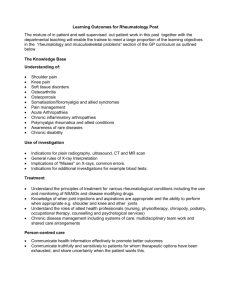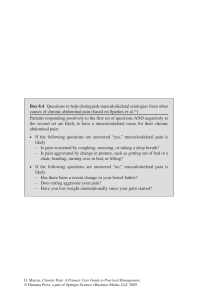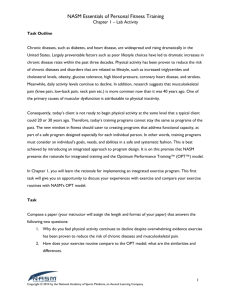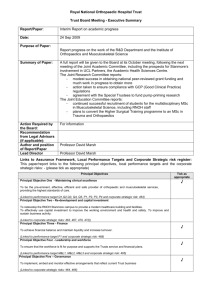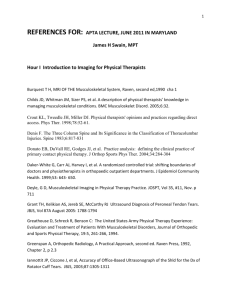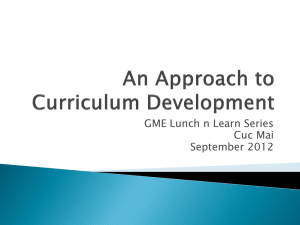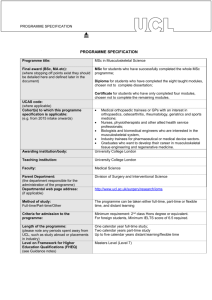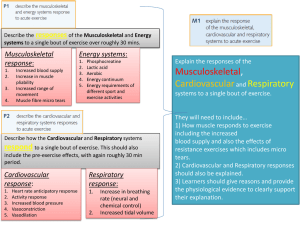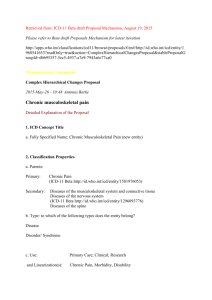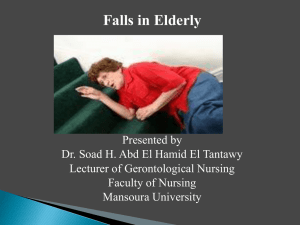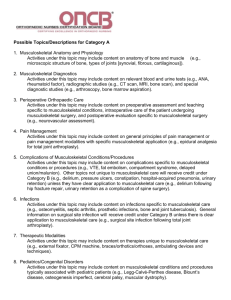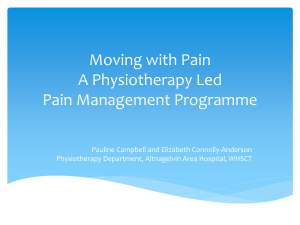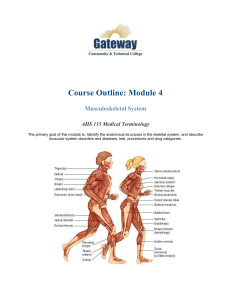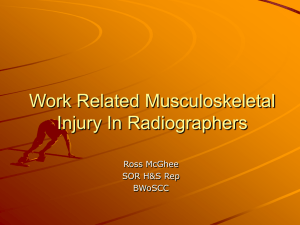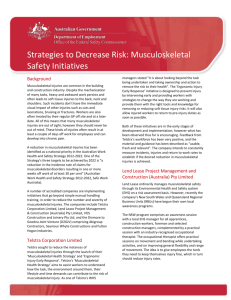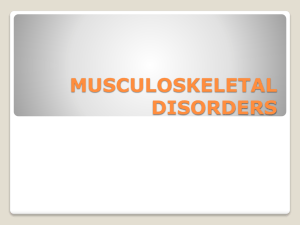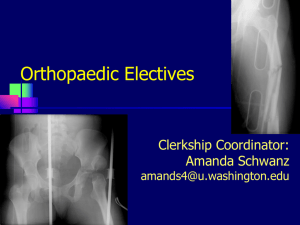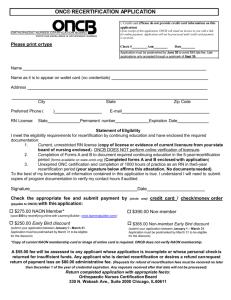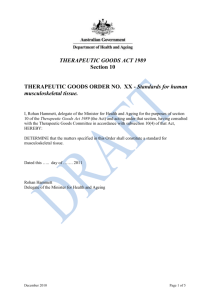Orthopaedics Learning Outcomes
advertisement
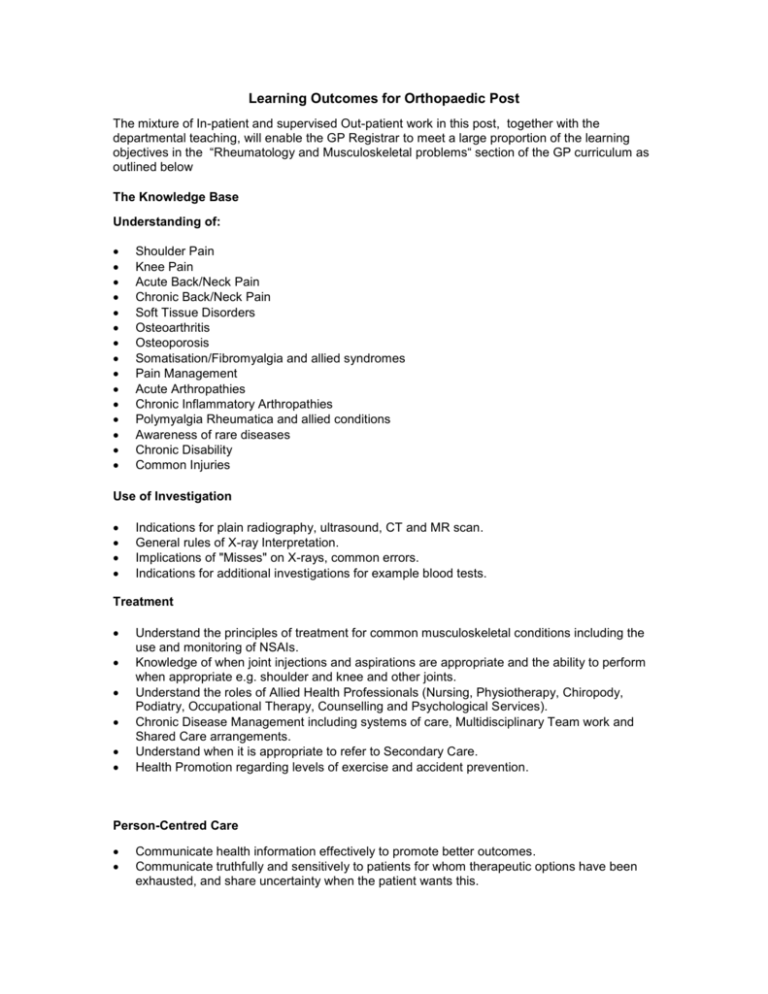
Learning Outcomes for Orthopaedic Post The mixture of In-patient and supervised Out-patient work in this post, together with the departmental teaching, will enable the GP Registrar to meet a large proportion of the learning objectives in the “Rheumatology and Musculoskeletal problems“ section of the GP curriculum as outlined below The Knowledge Base Understanding of: Shoulder Pain Knee Pain Acute Back/Neck Pain Chronic Back/Neck Pain Soft Tissue Disorders Osteoarthritis Osteoporosis Somatisation/Fibromyalgia and allied syndromes Pain Management Acute Arthropathies Chronic Inflammatory Arthropathies Polymyalgia Rheumatica and allied conditions Awareness of rare diseases Chronic Disability Common Injuries Use of Investigation Indications for plain radiography, ultrasound, CT and MR scan. General rules of X-ray Interpretation. Implications of "Misses" on X-rays, common errors. Indications for additional investigations for example blood tests. Treatment Understand the principles of treatment for common musculoskeletal conditions including the use and monitoring of NSAIs. Knowledge of when joint injections and aspirations are appropriate and the ability to perform when appropriate e.g. shoulder and knee and other joints. Understand the roles of Allied Health Professionals (Nursing, Physiotherapy, Chiropody, Podiatry, Occupational Therapy, Counselling and Psychological Services). Chronic Disease Management including systems of care, Multidisciplinary Team work and Shared Care arrangements. Understand when it is appropriate to refer to Secondary Care. Health Promotion regarding levels of exercise and accident prevention. Person-Centred Care Communicate health information effectively to promote better outcomes. Communicate truthfully and sensitively to patients for whom therapeutic options have been exhausted, and share uncertainty when the patient wants this. Specific Problem-Solving Skills Describe the epidemiology of Musculoskeletal Disorders at all ages, and apply this when developing a differential diagnosis. Assess mechanism of injury when considering diagnosis. Distinguish inflammatory from non-inflammatory conditions. Assess the possibility that musculoskeletal symptoms can be due to psychological causes (somatisation). Describe when blood tests and imaging methods are required for diagnosis, how to interpret them and how they influence management. A Comprehensive Approach Describe problems that can be caused by the treatment of Musculoskeletal Disorders (e.g. GI bleeds, Osteoporosis, Coronary Heart Disease, Radiation damage) and explain Primary and Secondary Prevention of these. Advise patients regarding what they are physically able to do, according to their level of disability. Recognise that Psychosomatic symptoms are commonly described as Musculoskeletal Problems, and that Musculoskeletal Problems often have an important Psychological component. Consider the Physical, Psychological and Social impact of Musculoskeletal Conditions on individuals and their families and carers. Recognise that an acute illness may be an acute exacerbation of a chronic disease. Recognise the Psychological effects of Trauma. Assess the likelihood of Occupational Exposure as a cause of Musculoskeletal Disease. Describe the increased risk of acute events in patients with Chronic and Co-morbid Diseases. Identify Co-morbid Diseases. Describe the modifying effect of Chronic or Co-morbid Disease and its treatment on the presentation of acute illness. Contextual Aspects Describe the systems of care for Musculoskeletal Conditions, including the roles of Primary and Secondary Care, Shared Care arrangements, Multidisciplinary Teams and patient involvement. Attitudinal Aspects Demonstrate empathy and compassion towards patients with incurable, disabling or painful musculoskeletal conditions. Provide adequate information for informed consent before any procedure is undertaken. Psychomotor Skills Demonstrate complete examination of the following areas: The Neck and Back The Shoulder, Elbow, Wrist and Hand The Hip, Knee and Ankle Perform Joint Aspiration and Injections Demonstrate competence in Suturing Techniques and applying simple Dressings.
